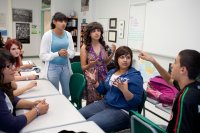A Litmus Test for Making Tech More Inclusive
A once-shy student is now a teacher working to make sure all students, even those who are quiet by nature, feel productive and included.
Educational technology can help encourage quiet students to become active participants in the classroom, says Stacey Roshan, math teacher and director of innovation and educational technology in Potomac, Maryland. Being called on in class was stressful and intimidating for Roshan throughout her education, she writes in a recent piece on reaching quiet kids in class for EdSurge. “I could never pay full attention because I always felt on alert,” Roshan says. “I was scared to be called on. I didn’t want to be put on the spot.” She recalls teachers frequently calling only on those who were first to raise their hands.
Her experience made her more sensitive to the needs of methodical thinkers and shy kids and informed her approach to facilitating class discussions. Roshan concluded that educational technology is a valuable tool “to engage students, inform individual and group instruction, differentiate lessons, document work, and empower students to direct their own learning.”
But creating safe spaces for all students, she says, requires vetting technology for the classroom. Over many years, Roshan developed the following questions to assess whether educational technology is appropriate and useful which she uses as a rubric when deciding whether to adopt a technology solution:
- Does it give each child a chance to participate, even if they are not the first to answer?
- “Does it engage every learner in the room, and require them all to actively participate and respond to each question, form an opinion, and submit an answer?”
- Does it allow for students to share openly, without risk of exposure of their mistakes to other students?
- Is it efficient and effective for teachers to target not only class needs, but individual student needs?
- Does it vary the way students can respond to a question? Some students like oral discussion while others prefer written replies.
Frequent, well-planned use of the tools that meet her high standards makes them feel second-nature to the students. Roshan recommends Flipgrid which allows students to create and post videos in response to questions from both the teacher and other students—a less stressful scenario for a shy student than speaking to a whole class. EdPuzzle also passes her test: It’s a flipped classroom tool that enables students to interact with each other through video questions.
An inclusive classroom environment requires a culture shift from “first is best,” where the teacher calls on the first student to raise her hand, to one where all students feel safe and comfortable participating.
